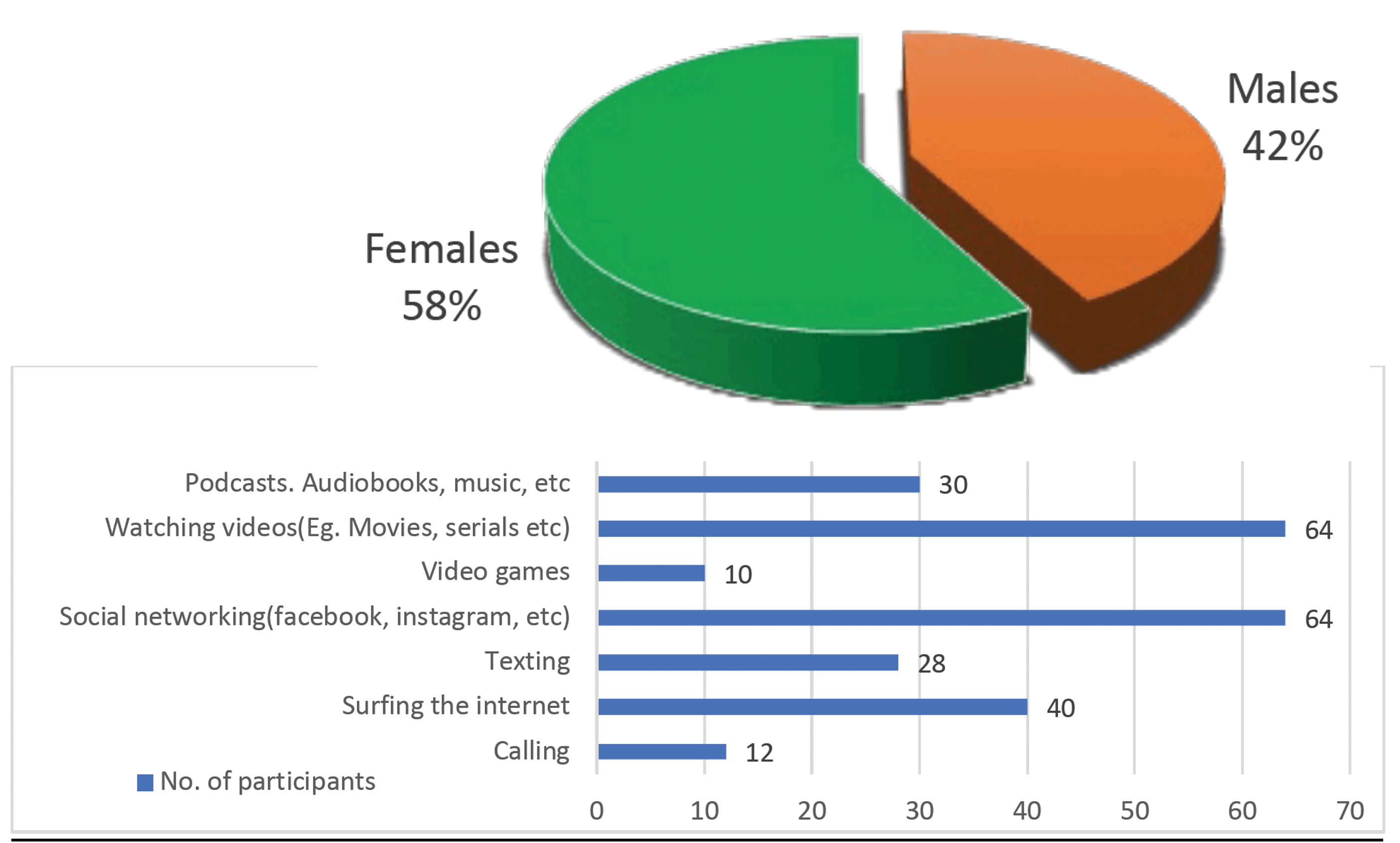A cross-sectional study on the effect of bedtime smartphone usage on sleep quality, sleep duration and daytime sleepiness in medical students
Main Article Content
Abstract
Background: Sleep is a physiological phenomenon. It is a condition of unawareness that the body regulates homeostatic. Sleep is essential because it plays a leading role in mental and physical function, removing toxins, preventing diseases, etc. Reduced sleep among young adults is becoming a significant health problem worldwide. Several factors have been shown to lead to poor sleep quality, but the reason smartphone use creates sleep disorders in young adults has attracted great curiosity for a few years. The study aimed to assess sleep quality, duration, and daytime sleep dysfunction among medical students who use their smartphones at bedtime.
Materials and methods: This cross-sectional study included 109 medical students. The data was collected using a pre-validated questionnaire about bedtime mobile phone usage and Pittsburgh sleep quality index (PSQI). The means were calculated, and the association was determined using statistical analysis.
Results: In the study, 60% of participants indicated poor sleep quality was due to prolonged bedtime smartphone usage. The average global PSQI score was 5.4±2.5.
Conclusion: This study concluded that participants had poor sleep quality measured by PSQI. In addition, prolonged smartphone usage during bedtime was strongly co-related to poor sleep latency.
Article Details

This work is licensed under a Creative Commons Attribution-NonCommercial-NoDerivatives 4.0 International License.
Personal views expressed by the contributors in their articles are not necessarily those of the Journal of Associated Medical Sciences, Faculty of Associated Medical Sciences, Chiang Mai University.
References
Owens, J. Adolescent sleep working group, and committee on adolescence. insufficient sleep in adolescents and young adults: an update on causes and consequences. Pediatrics 2014; 134(3): 921-32.
Munezawa, T, Kaneita, Y, Osaki, Y, Kanda H, Minowa M, Suzuki K, Higuchi S, Mori J, Yamamoto R, Ohida T. The association between use of mobile phones after lights out and sleep disturbances among Japanese adolescent: A Nationwide cross-sectional survey. Sleep 2011; 34(8): 1013-20.
Cain N, Gradisar M. Electronic media use and sleep in school-aged children and adolescents: A review. Sleep medicine. 2010; 11(8): 735-42.
13. Haug S, Castro RP, Kwon M, et al. Smartphone use and smartphone addiction among young people in Switzerland. J Behav Addict. 2015; 4: 299-307.
Buysse DJ, Reynolds III CF, Monk TH, Hoch CC, Yeager AL, Kupfer DJ. Quantification of subjective sleep quality in healthy elderly men and women using the Pittsburgh Sleep Quality Index (PSQI). Sleep. 1991; 14(4): 331-8.
Munezawa T, Kaneita Y, Osaki Y, Kanda H, Minowa M, Suzuki K, Higuchi S, Mori J, Yamamoto R, Ohida T. The association between use of mobile phones after lights out and sleep disturbances among Japanese adolescents: a nationwide cross-sectional survey. Sleep. 2011; 34(8): 1013-20.
Adams SK, Daly JF, Williford DN. Article commentary: Adolescent sleep and cellular phone use: Recent trends and implications for research. Health services insights. 2013; 6: HSI-S11083.
Dagmara D, Frances LC, Patrick M. The role of environmental factors on sleep patterns and school performance in adolescents. Front Psychol. 2015; 01: 17-24.
Haug S, Castro RP, Kwon M, et al. Smartphone use and smartphone addiction among young people in Switzerland. J Behav Addict. 2015; 4: 299-307. doi: 10.1556/2006.4.2015.03
Sahin S, Ozdemir K, Unsal A, et al. Evaluation of mobile phone addiction level and sleep quality in university students. Pak J Med Sci. 2013; 29: 913-8. doi: 10.12669/pjms.294.3686
Loughran SP, Wood A, Barton JM, et al. The effect of electromagnetic fields emitted by mobile phones on human sleep. NeuroReport. 2005; 16: 1973-6.
Pigeon WR, Cribbet MR. The pathophysiology of insomnia: from models to molecules (and back). Current opinion in pulmonary medicine. 2012; 18(6) :546-53.
Merriam-Webster's dictionary. 2016. Springfield: Merriam-Webster. [Google Scholar].
Cambridge. Cambridge: Cambridge University Press; 2016. Cambridge dictionary. [Google Scholar].
Hangouche AJ, Jniene A, Aboudrar S, Errguig L, Rkain H, Cherti M, Dakka T. Relationship between poor quality sleep, excessive daytime sleepiness and low academic performance in medical students. Advances in medical education and practice. 2018; 9: 631.
Fobian AD, Avis K, Schwebel DC. Impact of media use on adolescent sleep efficiency. J Dev Behav Pediatr. 2016; 37: 9-14.
Lemola S, Perkinson-Gloor N, Brand S, Dewald-Kaufmann JF, Grob A. Adolescents’ electronic media use at night, sleep disturbance, and depressive symptoms in the smartphone age. Journal of youth and adolescence. 2015; 44(2): 405-18.
Polos PG, Bhat S, Gupta D, O'Malley RJ, DeBari VA, Upadhyay H, Chaudhry S, Nimma A, Pinto-Zipp G, Chokroverty S. The impact of Sleep Time-Related Information and Communication Technology (STRICT) on sleep patterns and daytime functioning in American adolescents. Journal of adolescence. 2015; 44: 232-44.
Lockley SW, Brainard GC, Czeisler CA. High sensitivity of the human circadian melatonin rhythm to resetting by short wavelength light. J Clin Endocrinol Metab. 2003; 88: 502-5.
Rüger M, St Hilaire MA, Brainard GC, Khalsa SB, Kronauer RE, Czeisler CA, Lockley SW. Human phase response curve to a single 6.5 h pulse of short‐wavelength light. The Journal of physiology. 2013; 591(1): 353-63.
Chang AM, Aeschbach D, Duffy JF. Evening use of light-emitting e-Readers negatively affects sleep, circadian timing, and next-morning alertness. PNAS. 2015; 112: 1232-7.
Lockley SW, Gooley JJ. Circadian photoreception: spotlight on the brain. Curr Biol. 2006; 16(18): R795-7.
Daneault V, Hébert M, Albouy G, Doyon J, Dumont M, Carrier J, Vandewalle G. Aging reduces the stimulating effect of blue light on cognitive brain functions. Sleep. 2014; 37(1): 85-96.
Haug S, Castro RP, Kwon M, Filler A, Kowatsch T, Schaub MP. Smartphone use and smartphone addiction among young people in Switzerland. Journal of behavioral addictions. 2015; 4(4): 299-307.
Sahin S, Ozdemir K, Unsal A, Temiz N. Evaluation of mobile phone addiction level and sleep quality in university students. Pakistan journal of medical sciences. 2013; 29(4): 913.


